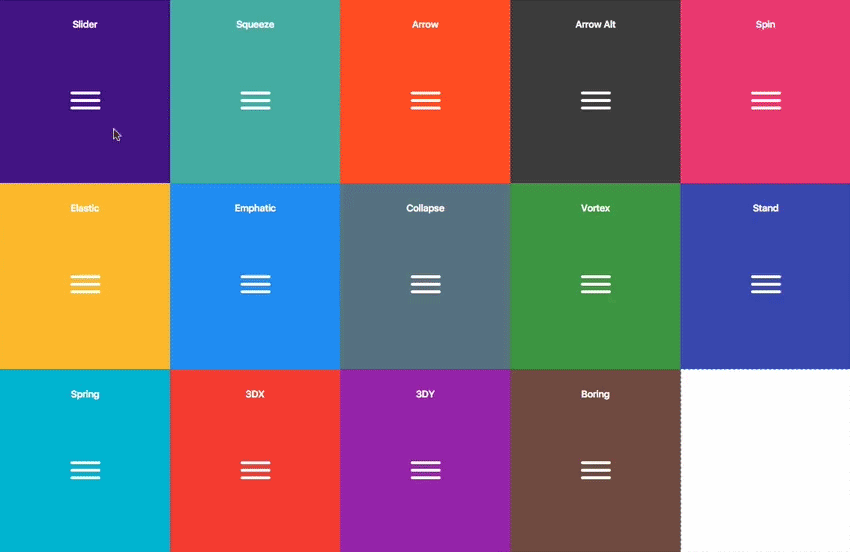# Hamburgers
Hamburgers is a collection of tasty CSS-animated hamburger icons. Also included is the source as a [Sass](#sass) library. It’s modular and customizable, so cook up your own hamburger.

### Table of Contents
- [Usage](#usage)
- [Sass](#sass)
- [Customization](#customization)
- [Accessibility](#accessibility)
- [Browser Support](#browser-support)
## Usage
1. [Download](https://github.com/jonsuh/hamburgers/blob/master/dist/hamburgers.css) and include the CSS in the `` of your site:
```html
```
2. Add the base hamburger markup:
```html
```
You *can* use `
`s if you insist, but they’re not [accessible](#accessibility) as a menu button.
```html
```
3. Append the class name of the type of hamburger you’re craving:
```html
```
Here’s the list of hamburger-type classes you can choose from:
```
hamburger--3dx
hamburger--3dx-r
hamburger--3dy
hamburger--3dy-r
hamburger--3dxy
hamburger--3dxy-r
hamburger--arrow
hamburger--arrow-r
hamburger--arrowalt
hamburger--arrowalt-r
hamburger--arrowturn
hamburger--arrowturn-r
hamburger--boring
hamburger--collapse
hamburger--collapse-r
hamburger--elastic
hamburger--elastic-r
hamburger--emphatic
hamburger--emphatic-r
hamburger--minus
hamburger--slider
hamburger--slider-r
hamburger--spin
hamburger--spin-r
hamburger--spring
hamburger--spring-r
hamburger--stand
hamburger--stand-r
hamburger--squeeze
hamburger--vortex
hamburger--vortex-r
```
Note: `-r` classes are reverse variants (e.g. `hamburger--spin` spins clockwise whereas `hamburger--spin-r` spins counterclockwise.
4. Trigger the active state by appending class name `is-active`:
```html
```
Since the class name would have to be toggled via JavaScript and implementation would differ based on the context of how you plan on using the hamburger, I’m going to leave the rest up to you.
## Sass
`.scss` source files are available if you use Sass as your CSS precompiler. It’s customizable and modular.
1. Hamburgers is available on [npm](https://www.npmjs.com/package/hamburgers), yarn and [Bower](http://bower.io/search/?q=css-hamburgers).
```
npm install hamburgers
yarn add hamburgers
bower install css-hamburgers
```
Also available as a [Ruby gem](https://rubygems.org/gems/hamburgers) to use within your Rails application—see [below](#install-for-ruby-on-rails) for more information.
Or to manually install it, [download](https://github.com/jonsuh/hamburgers/archive/master.zip) and unzip the source files, then copy the files from the `_sass/hamburgers` directory into your project.
2. Import the `hamburgers.scss` file in your Sass manifest file:
```scss
@import "path/to/hamburgers";
```
3. Customize your hamburger and/or remove any types you don’t want in `hamburgers.scss`.
4. Compile your Sass*, and voila!
\* Be sure to run the CSS through [Autoprefixer](https://github.com/postcss/autoprefixer) since the Sass doesn’t account for vendor prefixes.
### Install for Ruby on Rails
1. Add Hamburgers to your Gemfile.
```
gem 'hamburgers'
```
2. Run `bundle install`.
3. Include Hamburgers by using Sass’s native `@import`**:
```scss
// application.scss
@import "hamburgers";
```
\** [More information](https://blog.pivotal.io/pivotal-labs/labs/structure-your-sass-files-with-import) on why Sass’s native `@import` + why you should ditch Sprockets directives altogether.
## Customization
To override default settings, declare them before importing Hamburgers:
```scss
$hamburgers-padding-x: 20px;
$hamburgers-padding-y: 15px;
$hamburger-types : (collapse);
@import "hamburgers";
```
You can also create a separate file (e.g. `hamburgers-settings.scss`) with those declarations, then import it before Hamburgers:
```scss
@import "hamburgers-settings"
@import "hamburgers";
```
Here is the full list of default settings (found in `_sass/hamburgers/hamburgers.scss`);
```scss
$hamburger-padding-x : 15px;
$hamburger-padding-y : 15px;
$hamburger-layer-width : 40px;
$hamburger-layer-height : 4px;
$hamburger-layer-spacing : 6px;
$hamburger-layer-color : #000;
$hamburger-layer-border-radius : 4px;
$hamburger-hover-opacity : 0.7;
$hamburger-hover-transition-duration : 0.15s;
$hamburger-hover-transition-timing-function: linear;
// To use CSS filters as the hover effect instead of opacity,
// set $hamburger-hover-use-filter as true and
// change the value of $hamburger-hover-filter accordingly.
$hamburger-hover-use-filter: false;
$hamburger-hover-filter : opacity(50%);
// Remove or comment out the hamburger types you don’t want
// or need, so they get excluded from the compiled CSS.
$hamburger-types: (
3dx,
3dx-r,
3dy,
3dy-r,
3dxy,
3dxy-r,
arrow,
arrow-r,
arrowalt,
arrowalt-r,
arrowturn,
arrowturn-r,
boring,
collapse,
collapse-r,
elastic,
elastic-r,
emphatic,
emphatic-r,
minus,
slider,
slider-r,
spring,
spring-r,
stand,
stand-r,
spin,
spin-r,
squeeze,
vortex,
vortex-r
);
```
#### `ems` or `rems`
Wanna work with `ems` or `rems` instead of `px`? Just change all the `px` values to the unit of your choice. Note: Be consistent (all `px` or all `ems`), otherwise it may break—the math behind the customization will fail if it attempts to perform operations with values of different units.
### Not satisfied?
Dig into `_base.scss` or `types/` and customize to your heart’s content. Fair warning: It‘s pretty delicate and may break, especially if you tweak the animations themselves.
## Accessibility
Hamburger menu icons can be useful in the right context, but they’re not the most accessible.
ARIA will help make it accessible to people with disabilities.
```html
```
You will need JavaScript to toggle between `aria-expanded` attribute being set to `true` and `false`, as this will indicate to visually impaired users whether the menu is opened or closed.
The hamburger button belongs __inside__ the `